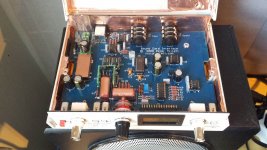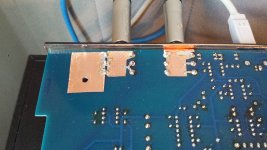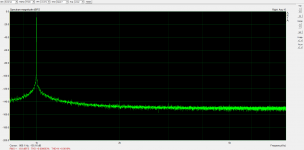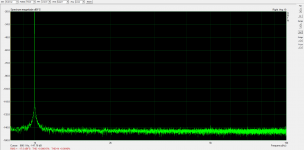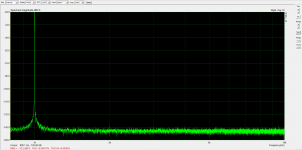What is Julie reporting?
I see wiggles around 0.0002% to 0.0007% (2 to 7ppm)
What is this and relative to what?
I see wiggles around 0.0002% to 0.0007% (2 to 7ppm)
What is this and relative to what?
What is Julie reporting?
I see wiggles around 0.0002% to 0.0007% (2 to 7ppm)
What is this and relative to what?
does this mean that we are seeing spot measurements of the internal noises over the frequency spectrum relative to 2Vac (2.82Vpk) plotted for the report?It's loopback through the soundcard interface at 2VRMS
The signal amplitude at GEN OUT / INPUT is 2VRMS.
If thats not what your asking I dont understand your question?
If thats not what your asking I dont understand your question?
What's confusing me is the lack of the reference frequency for the THD measurement.
It should show on the plot. Or does arta do it differently?
It should show on the plot. Or does arta do it differently?
My understanding is that ARTA calculates the THD based on the highest peak in the FFT and normalizes it to signal power.
Hi. Does anyone have one of these interfaces cards that are willing to sell?
Kind regards
Richard
Sent you a pm
Here are a couple of internal pictures ... should clean off that flux residue...
Hi Tazz your results are fantastic, can you please elaborate on the mods you've made and the pictures that you've posted; like what have you soldered onto the underside of the 6mm sockets etc. I've recently finished one of these interfaces and I'd like to get it performing as well as yours.
I finally ordered the bulk of parts today and ...oops...forgot to order the switching diodes(1n4148). I should be able to get away with 1n914b, right? Specs look awfully close and I have 100s of these.
They are equivalent.
http://www.vishay.com/doc?85622
Vishay - 1N4148 - Small Signal Fast Switching Diodes
The 1N4148 datasheet states they are equivalent
http://www.vishay.com/doc?85622
Vishay - 1N4148 - Small Signal Fast Switching Diodes
The 1N4148 datasheet states they are equivalent
I think the 1N914 and 1N4148 are electrically identical for practical purposes. If memory serves me, the 1N4448 is a 1N4148, but with tighter windows on several of the spec characteristics. (I.e., the stated "Nominal" values are the same but the 1N4448 has less spread between "Max" and "Min" than the 1N4148.)I finally ordered the bulk of parts today and ...oops...forgot to order the switching diodes(1n4148). I should be able to get away with 1n914b, right? Specs look awfully close and I have 100s of these.
Dale
Dale, thanks for chiming in as well. Looks like I'm good for now but I will report back if any issues found.
I have one of these fully assembled and shielded in mumetal. Using THAT 1240s, THAT 1646P08s, and an LME49720. I'm not using it anymore, so if anyone wants it for my price in parts just drop me a message.
Hi Tazz your results are fantastic, can you please elaborate on the mods you've made and the pictures that you've posted; like what have you soldered onto the underside of the 6mm sockets etc. I've recently finished one of these interfaces and I'd like to get it performing as well as yours.
Those are RFI filter capactiors as described in the apnotes for the THAT parts. The green PCB's are back to back depletion mode mosfets for the input protection and an additional common mode filter for the isolated converter.
When using this interface with a juli@ soundcard the 1Vrms out @ FS really puts a limit on the usable dynamic range. So I removed D10/D12 so I can get a larger output voltage swing before clipping. (I will probobly increase the diode stack to still get protection just at a level more suitable for the juli@)
Unfortunately this puts the meter out of range but look at the performence I get when measuring one "mikevich" <0.00001% 1kHz oscillators of ebay
This is with the soundcard interface at the 200mV setting and the oscillator set for about 0.6V
Attachments
Last edited:
- Home
- Design & Build
- Equipment & Tools
- Test & Measurement interface for Soundcard
